Counterfeit $20 sábanas Type 1


The characteristics listed in the Sebastián Vargas' notice of 21 March 1914, which summarises characteristics of four values, are as follows:
| GENUINE | COUNTERFEIT |
| letters are thicker (más gruesos) | |
| ink is blacker | |
|
edging frame is made up of plates so slight breaks in corners |
edging is continuous in the corners |
|
Chao’s signature stroke ends in a thick flourish |
Chao’s signature ends in a lump (bola o nudo) |
The notice of 24 March 1914 lists:
| GENUINE | COUNTERFEIT |
|
Rubber seal, printed in different colours |
Steel seal, printed in a single colour, without a bar after ‘CHIHUAHUA’ |
| Small joints at the corners and various parts of edging |
Edging appears continuous |
| Either ‘No’ ‘No’ in red, or a single ‘Num’ in black | Single ‘Num’ in black |
|
In ‘TESORERIA’ ‘I’ separated from ‘A’ |
‘I’ joined to foot of ‘A’ |
|
In ‘DEL ESTADO’ the 'DE' (se desprenden de las rectas de cada letra) (?) |
'DE' are joined at the top (?) |
|
|
|
| Type finer | Type thicker |
|
|
|
|
Comma after ‘Interventor’ |
Point after ‘Interventor’ |
| The initial angle of Vargas' signature is thinner | Thicker |
| the hatching lines in ‘VEINTE PESOS’ are fine and separate | lines are very coarse (muy toscas) |
| In the majority, a bolita in Chao’s signature |
The missing comma after 'Gobernador Provisional del Estado' is also mentioned in the notice of December 1914.
Counterfeit $20 sábanas Type 1a
On 26 March 1914 Pedro Maese, the collector of customs at Ciudad Juárez and the expert who determined which money was counterfeit and which genuine, testified before a United States commissioner's court in El Paso, in the case of J. G. Sperro, charged with having in his possession forged and counterfeit money of a foreign countryEl Paso Herald, 26 March 1914. Maese outlined the following differences:
| GENUINE | COUNTERFEIT |
|---|---|
|
|
|
| heavier paper | |
| the angle of the flourish of Vargas’ signature is much heavier |
In March 1914 the El Paso HeraldEl Paso Herald, 27 March 1914 reported that local businessmen were doing a bit of expert money examination on their own initiative. Having obtained one of the notes that has been restamped in Ciudad Juárez, they compared all money that was offered them and if it compared well they accepted it in payment for goods and in exchange for American money at the prevailing rate. There were many ways to distinguish between bad and good rebel money. By placing two of the notes side by side, the difference could be readily seen but the only difficulty was is in telling which was genuine and which was bogus. The newspaper said that the $20 sábanas had been most widely counterfeited and the differences it listed were:
| GENUINE | COUNTERFEIT |
|---|---|
| printing in background is much paler green | |
| serial number in the upper right hand corner several shades lighter | |
| letters used for printing bolder | |
| impression much heavier | |
| 'CHIH.' in printers' imprint |
'CHTH.' |
| green 'viente' easy to read | 'viente' does not appear plainly |
 rubber stamp rubber stamp |
 stamped with steel die stamped with steel die |
The notice of December 1914 also mentions:
| GENUINE | COUNTERFEIT |
|---|---|
|
comma after ‘Gobernador Provisional del Estado’ |
 no comma no comma |
These notes, which include the three examples from the Supreme Court in Chihuahua, also have
| GENUINE | COUNTERFEIT |
|
comma after ‘VALIDO’ |
no comma |
 |
 dot just below the curve of the P of ‘PESOS’ dot just below the curve of the P of ‘PESOS’ |
A report on A 11093 was "(1) the line "VEINTE PESOS" on the face is 3 mm shorter than on other notes. (2) Its black border lines, both outer and inner, are thicker and more prominent. (3) Its bold black signatures appear to have been printed as a part of the note plate, instead of having been added later. (5) Its face under-print which should be light green is virtually invisible, as well its large letters reading VEINTE $20 PESOS and the rest of the background design. (6) Its serial numbers are in bright red with some orange mixed in, as opposed to the brownish red on other notes. (7) It is printed on a whiter, slightly heavier paper than other notes".
In table form:
| GENUINE | COUNTERFEIT |
| VEINTE PESOS on face is 3 mm shorter | |
| black border lines thicker and more prominent | |
| signatures added | signatures printed as part of the note plate |
| face underprint virtually invisible | |
| VEINTE $20 PESOSon reverse virtually invisible | |
| serial numbers brownish red | serial numbers bright red |
| printed on a whiter, slightly heavier paper |















